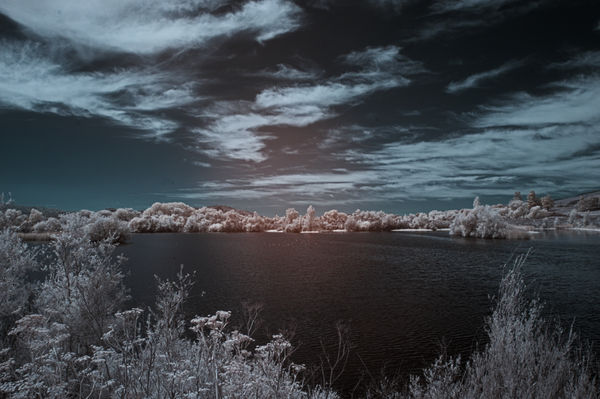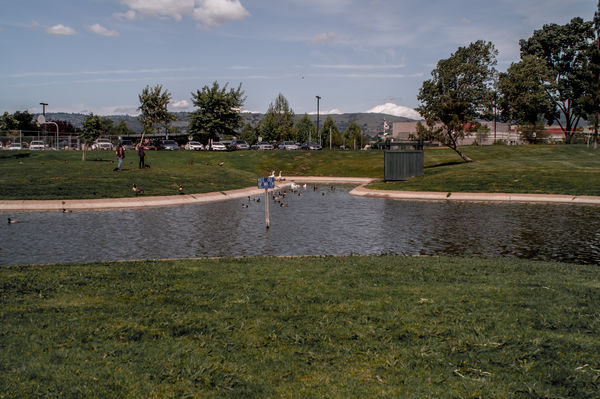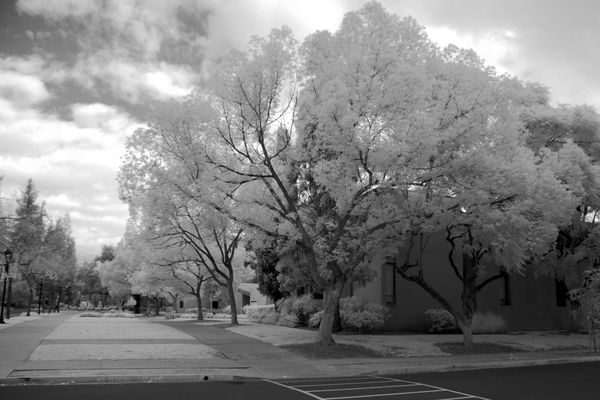Infared
Jan 18, 2015 16:07:02 #
Would someone please explain how to do infared photography
Jan 18, 2015 16:13:26 #
buffyjean,
your best options are to use the search feature on this site or use google.
your best options are to use the search feature on this site or use google.
Jan 18, 2015 16:17:50 #
Google "Infrared photography" with your camera type.
buffyjean wrote:
Would someone please explain how to do infared photography
Jan 18, 2015 16:32:29 #
buffyjean wrote:
Would someone please explain how to do infared photography
try this article
http://www.pcmag.com/article2/0,2817,2336279,00.asp
Jan 18, 2015 17:11:10 #
buffyjean wrote:
Would someone please explain how to do infared photography
Possibly not. Maybe infrared photography if you ask nicely! :)
What are you using for a camera? With film it is relatively easy, you just buy some infrared film. With digital, most sensors have filters to eliminate most of the infrared spectrum which makes things a bit more challenging.
There is plenty of information available on the web in general and also on UHH.
Have you heard of Mr. Google? He might be willing to help!
http://www.google.com/search?q=infrared+photography&ie=utf-8&oe=utf-8
Jan 18, 2015 18:19:31 #
buffyjean wrote:
Would someone please explain how to do infared photography
I don't think you have gotten very useful answers so far. Infrared is that portion of the spectrum just beyond red that our eyes cannot see, but a camera's sensor can. In order to prevent that infrared light from spoiling the image we are trying to capture, manufactures place a filter in front of the sensor that blocks most of the infrared light from reaching the sensor.
I say most, because the filters aren't perfect, and there is some leakage, however it is small. Some cameras allow more of this infrared to pass through than others. I have seen places on the web where someone has taken the time to collect information on which cameras can be used for this and which ones are not good for this, but its a moving target since new camera keep coming out.
A quick test to see if your camera is even sensitive is to watch through the camera and press buttons on a TV remote. If you can see the infrared light, then there is hope your camera can do it.
But the problem here is that very little infrared light is actually making it to the sensor, and once you place a suitable filter on the lens to block out visible light, you are facing long exposure times to get an image.
An alternative to this is to have a camera modified to be able to capture IR light. This involves the removal of the previously mentioned filter. And possibly a new filter that blocks visible light. There are arguments for both ways. I have one without a filter, more commonly called a "Full Spectrum" camera, and it is a must that I provide the correct filter on the lens. But I can pick from several different filters and get different effects.
The next step after taking the pictures is the processing. If you just look at the results, they look very red and not very pretty. You can turn that into B&W rather easily and get some stunning results. Depending on the filter used, the results can vary.
If you are using a filter closer to the red color such as 590 nm, or 650 nm or 720 nm, you can do a trick involving swapping the red and blue color channels and end up with something called psuedo colors that can be eerie, but beautiful. The lower the wave length, for istance, 590 vs 720, the more visible light is mixed with the IR light, and the results are different.
Should you buy or have modified a camera to do this, first of all, it works best if the camera can shoot RAW. You need the flexibility to adjust the White Balance a long ways to get the effect you are looking for, and JPEG doesn't cut it.
And also, it the camera came with a cheap "kit" lens, that lens may produce what is called a hot spot in the center meaning that the lens is not uniform on the amount of IR that passes through. I have a modified Sony A55. With the 18-55mm kit lens, I have a hot spot. With rather cheap Minolta Maxxum lens, which work fine on Sony cameras, there is no hot spot.
With a modified camera, IR photography can be very fun.
Jan 18, 2015 19:23:11 #
JimH123 wrote:
I don't think you have gotten very useful answers ... (show quote)
I had a Nikon D70s camera converted to IR by LifePixel.com, one of the leading companies doing conversions. Their website has a lot of good information about types of filters available and postprocessing tutorials. I decided on a internal replacement filter because with a filter on the lens you have to view and focus through it, and the exposure times can be too long to shoot handheld. I knew I wanted to try false color IR, so I went with a filter that would work for that. I can also convert to B&W although I have to increase the contrast more in postprocessing than I would with a pure B&W IR filter. Some of my false color work and a couple B&W are at:http://swandaschindler.com/infrared/photos.htm
Jan 18, 2015 20:11:04 #
Jan 18, 2015 20:25:29 #
JohnSwanda wrote:
I had a Nikon D70s camera converted to IR by LifeP... (show quote)
I went the other way. I have no filter in the camera and I have to use an external. I have found that the image is very usable in live view. I also focus manually since the camera is adjusting slightly incorrectly for IR light. When I watch it on the LCD, I adjust to be in perfect focus, and the shots turn out correct.
i WENT THE
Jan 19, 2015 02:29:08 #
JimH123 wrote:
I went the other way. I have no filter in the camera and I have to use an external. I have found that the image is very usable in live view. I also focus manually since the camera is adjusting slightly incorrectly for IR light. When I watch it on the LCD, I adjust to be in perfect focus, and the shots turn out correct.
i WENT THE
i WENT THE
This picture is an example of taking a camera modified to be a full spectrum camera and adding an external IR blocking filter to revert back to a normal camera.
The camera has no internal filter at all. That is why it is called "Full Spectrum". I have 4 IR type filters (different wave lengths) which I can use depending on what I feel like doing. And with an IR blocking filter, it goes back to being a normal camera, although I don't actually do this very often.
Jan 19, 2015 02:53:28 #
JimH123 wrote:
This picture is an example of taking a camera modified to be a full spectrum camera and adding an external IR blocking filter to revert back to a normal camera.
The camera has no internal filter at all. That is why it is called "Full Spectrum". I have 4 IR type filters (different wave lengths) which I can use depending on what I feel like doing. And with an IR blocking filter, it goes back to being a normal camera, although I don't actually do this very often.
The camera has no internal filter at all. That is why it is called "Full Spectrum". I have 4 IR type filters (different wave lengths) which I can use depending on what I feel like doing. And with an IR blocking filter, it goes back to being a normal camera, although I don't actually do this very often.
That is interesting. So if you use IR blocking filters for a normal rendition, what if anything do you use for IR images? IR filters or something else, or nothing?
Full spectrum stuff sounds interesting, yet complicated.
Jan 19, 2015 03:04:53 #
Peterff wrote:
That is interesting. So if you use IR blocking filters for a normal rendition, what if anything do you use for IR images? IR filters or something else, or nothing?
Full spectrum stuff sounds interesting, yet complicated.
Full spectrum stuff sounds interesting, yet complicated.
For IR images, I can pick from 590nm, 650nm, 720nm or 850nm. I have all 4. 590nm let's the most visible light in. And 850nm can only be used for B&W and has the highest contrast.
This is why it is called a "Full Spectrum". Since there is no internal filter, I have to supply the filter externally. If I use no filter at all, the picture is rather ugly and useless since so much IR light is mixed with visible light.
Jan 19, 2015 03:18:03 #
With my Nikon D80 converted to infrared, it is quite easy to take either black and white photos, or color if that is your preference. Here is a sample I took about a week ago at Claremont College.
Jan 19, 2015 03:18:19 #
JimH123 wrote:
For IR images, I can pick from 590nm, 650nm, 720nm or 850nm. I have all 4. 590nm let's the most visible light in. And 850nm can only be used for B&W and has the highest contrast.
This is why it is called a "Full Spectrum". Since there is no internal filter, I have to supply the filter externally. If I use no filter at all, the picture is rather ugly and useless since so much IR light is mixed with visible light.
This is why it is called a "Full Spectrum". Since there is no internal filter, I have to supply the filter externally. If I use no filter at all, the picture is rather ugly and useless since so much IR light is mixed with visible light.
Forgive my ignorance of this topic please, so for infrared shots you might take a Hoya R-72 Infrared Filter for example, maybe apply a custom white balance when you take the shot if you wish (or not), and then you get an infrared image to play with.
Is that along the right lines or am I completely off base...
Thanks, and appreciated.
Jan 19, 2015 03:22:52 #
jfn007 wrote:
With my Nikon D80 converted to infrared, it is quite easy to take either black and white photos, or color if that is your preference. Here is a sample I took about a week ago at Claremont College.
So your image, which is very nice, is infrared, and needs no additional filters on the lens, (EXIF data would be nice, not sure how to get it from the posted image).
This is not however a full spectrum camera from what you are saying, just infrared only? Is that correct?
Many thanks...
If you want to reply, then register here. Registration is free and your account is created instantly, so you can post right away.









